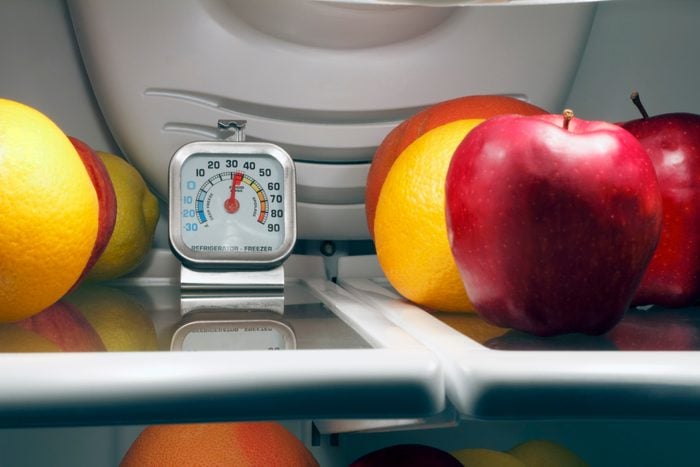This Is the Safest Temperature for Your Fridge
Updated: May 19, 2023

Keep your food fresh longer—and help prevent foodborne illness—by finding the ideal refrigerator temperature.
Is your food going bad more quickly than usual? (Psst! Here’s how long fresh produce should last.) If produce is wilted, cheese is warm and ice cream is coming out of the freezer like soup, your fridge temp might need a checkup.
The Best Temperature for Your Fridge
The ideal refrigerator temperature is at or below 40°F (4°C), and your freezer temperature should be 0°F (-18°C). While some refrigerators and freezers are outfitted with all the bells and whistles, they might not have a built-in thermometer. Fortunately, appliance thermometers are generally inexpensive and can be found in most kitchen appliance stores or on Amazon.
Finding the optimal refrigerator temperature is key to making sure that your produce and leftovers last as long as possible, and is one of the easiest ways to prevent foodborne illnesses from eating expired and rancid milk, eggs and dairy. While properly freezing is a great way to store bulk items like meat, the FDA notes that it does affect “tenderness, flavor, aroma, juiciness, and color” the longer that your foods are frozen. Here’s our guide to navigating foods with freezer burn.
If you’re worried about your leftovers going bad before you can get to them, get creative! As our food editor, Peggy Woodward, says, “Leftover meat can be added to a simple soup or combined with eggs into a flaky quiche or frittata. If you have a small amount of leftover cooked vegetables, put an egg on top and enjoy the dish for supper. Leftover grains make tasty fried rice. Fruits can go into a fruit salad, chopped vegetables into a stir-fry.” Try these recipes for leftover chicken, too.
Why Is My Refrigerator Freezing Food?
It’s frustrating when you open your refrigerator and find frozen food. Especially when something freezes that can’t be salvaged, like lettuce or other fresh produce. Is the fridge broken? What’s going on? Luckily, a freezing issue can usually be fixed with a simple solution. Here are few possible reasons your fridge is getting too cold.
Temperature Setting
Check the temperature setting on your refrigerator. It should be set between 37°F and 40°F—the ideal refrigerator temperature to keep food fresh and cold but not frozen. If you have a numbered dial setting instead of a temperature reading, the highest number is the coldest (usually 5). Appliance brands recommend keeping it on the coldest setting, but if your food is freezing, try turning it down to 4.
Food Placement
Refrigerators need sufficient air circulation to maintain a proper temperature. Make sure your fridge isn’t overloaded, and that food isn’t blocking any of the air vents. On the other hand, an under stocked fridge can be a problem as well. Without enough items inside the fridge, the cold air settles at the bottom of the fridge and might freeze the food in your bottom drawers.
Leak in the Door Seal
If your fridge is leaking cold air due to a faulty door seal, the fridge will constantly be running trying to keep the temperature at the right level. And if your fridge is working in overdrive, it could cause freezing (or worse yet, the motor to go out!). Inspect the door seal and look for tears or warping, then replace if needed.
The Best Refrigerator Rules to Follow
Regularly monitoring your thermometer is the best way to make sure your food is safe, but just in case your refrigerator or freezer gets too warm or chilly, there are ways to ensure everything is working properly.
- Close the door! It’s easy to leave the door open while you’re cooking or unpacking groceries, but only leave the doors open when absolutely necessary.
- Spread out your food. It seems silly, but keep your food spread out so air can properly flow through the fridge and freezer. A fully stocked fridge is more likely to be warmer than a less stocked one.
- Clean your coils. Like other appliances, your fridge might need a little TLC from time to time. Make sure to clean the coils at least once per year to avoid refrigerator repairs.
